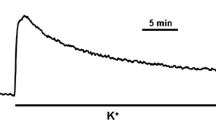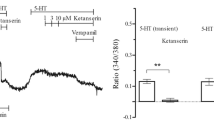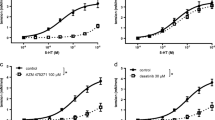Abstract
Neuropeptide Y(NPY) inhibits Ca2+-activated K+ channels reversibly in vascular smooth muscle cells from the rat tail artery. NPY (200 μM) had no effect in the absence of intracellular adenosine 5′triphosphate (ATP) and when the metabolic poison cyanide-M-chlorophenyl hydrozone (10 μM) was included in the intracellular pipette solution. NPY was also not effective when ATP was substituted by the non-hydrolysable ATP analogue adenosine 5′-[β, γ-methylene]-triphosphate (AMP-PCP). NPY inhibited Ca2+-activated K+ channel activity when ATP was replaced by adenosine 5′-O-(3-thiotriphosphate) (ATP [γ-S]) and the inhibition was not readily reversed upon washing. Protein kinase inhibitor (1 μM), a specific inhibitor of adenosine 3′, 5′-cyclic monophosphatedependent protein kinase, had no significant effect on the inhibitory action of NPY. The effect of NPY on single-channel activity was inhibited by the tyrosine kinase inhibitor genistein (10 μM) but not by daidzein, an inactive analogue of genistein. These observations suggest that the inhibition by NPY of Ca2+-activated K+ channels is mediated by ATP-dependent phosphorylation. The inhibitory effect of NPY was antagonized by the tyrosine kinase inhibitor genistein.
Similar content being viewed by others
References
Aiello E, Walsh M, Cole W (1995) Phosphorylation by protein kinase A enhances delayed rectifier K+ current in rabbit vascular smooth muscle cells. Am J Physiol 268:H926-H934
Akiyama T, Ishida J, Nakagawa S, Ogawara H, Watanabe S, Itoh N, Shibuya M, Fukami Y (1987) Genistein, a specific inhibitor of tyrosine-specific protein kinases. J Biol Chem 262:5592–5595
Bolzon BJ, Cheung DW (1989) Isolation and characterization of single vascular smooth muscle cells from spontaneously hypertensive rats. Hypertension 14:137–144
Bolzon BJ, **ong Z, Cheung DW (1993) Membrane rectification in single smooth muscle cells from the rat tail artery. Pflügers Arch 425:482–490
Cheng H, Kemp B, Pearson R, Smith A, Misconi L, van Patten S, Walsh D (1986) A potent synthetic peptide inhibitor of the cAMP-dependent protein kinase. J Biol Chem 261:989–992
Cheung DW (1991) Neuropeptide Y potentiates specifically the purinergic component of the neural responses in the guinea pig saphenous artery. Circ Res 68:1401–1407
Ewald D, Williams A, Levitan I (1985) Modulation of single Ca2+-dependent K+ channel activity by protein phosphorylation. Nature 315:503–506
Fabiato A (1988) Computer programs for calculating total from specified free or free from specified total ionic concentrations in aqueous solutions containing multiple metals and ligands. Methods Enzymol 157:378–417
Hamill OP, Marty A, Neher E, Sakmann B, Sigworth F (1981) Improved patch-clamp techniques for high-resolution current recording from cells and cell-free membrane patches. Pflügers Arch 391:85–100
Larhammar D, Blomqvist A, Yee F, Jazin E, Yoo H, Wahlestedt C (1992) Cloning and functional expression of a human neuropeptide Y/peptide YY receptor of the Y1 type. J Biol Chem 267:10935–10938
Lundberg JM, Pernow J, Lacroix J (1989) Neuropeptide Y: sympathetic cotransmitter and modulator? News Physiol Sci 4:13–17
Sadoshima J, Akakike N, Kanaide H, Nakamura M (1988) Cyclic AMP modulates Ca2+-activated K+ channel in cultured smooth muscle cells of rat aortas. Am J Physiol 255: H754-H759
Shigeri Y, Fujimoto M (1994) Y2 receptors for neuropeptide Y are coupled to three intracellular signal transduction pathways in a human neuroblastoma cell line. J Biol Chem 269:8842–8848
Siegelbaum SA (1994) Ion channel control by tyrosine phosphorylation. Curr Biol 4:242–245
Small DL, Bolzon BJ, Cheung DW (1992) Endothelium-independent potentiating effects of neuropeptide Y in the rat tail artery. Eur J Pharmacol 210:131–136
Tsuda T, Kawahara Y, Shii K, Koide M, Ishida Y, Yokoyama M (1991) Vasoconstrictor-induced protein-tyrosine phosphorylation in cultured vascular smooth muscle cells. FEBS Lett 285:44–48
Wijetunge S, Aalkjaer C, Schachter M, Hughes AD (1992) Tyrosine kinase inhibitors block calcium channel currents in vascular smooth muscle cells. Biochem Biophys Res Commun 189:1620–1623
**ong Z, Cheung DW (1994) Neuropeptide Y inhibits Ca2+activated K+ channels in vascular smooth mucle cells from the rat tail artery. Pflügers Arch 429:280–284
**ong Z, Bolzon BJ, Cheung DW (1993) Neuropeptide Y potentiates calcium-channel currents in single vascular smooth muscle cells. Pflügers Arch 423:504–510
**ong Z, Burnette E, Cheung DW (1995) Modulation of Ca2+ activated K+-channel activity by tyrosine kinase inhibitors in vascular smooth muscle cell. Eur J Pharmacol 288:79–88
Author information
Authors and Affiliations
Rights and permissions
About this article
Cite this article
**ong, Z., Cheung, D.W. ATP-Dependent inhibition of Ca2+-activated K+ channels in vascular smooth muscle cells by neuropeptide Y. Pflügers Arch. 431, 110–116 (1995). https://doi.org/10.1007/BF00374383
Received:
Accepted:
Issue Date:
DOI: https://doi.org/10.1007/BF00374383




